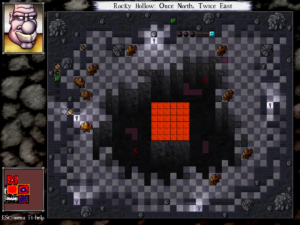DROD: Giants
 By now, I seem to have pretty much left the City behind. The story has taken me to the forgotten spaces below the city, home to the Stone Giants.
By now, I seem to have pretty much left the City behind. The story has taken me to the forgotten spaces below the city, home to the Stone Giants.
Stone giants are what would be called “Large” in Dungeons & Dragons. That is, they have a 2×2 footprint. Although they look more threatening this way, the larger size doesn’t make them more more powerful or even let them move faster. Quite the reverse: it limits their mobility. There are puzzles to be made from this weakness, by forcing the player to either take advantage of it (ducking into narrow tunnels to escape them), or overcome it (herding them through difficult passages). When hurt, stone giants break apart into four one-tile stone golems (a familiar monster from JtRH), leading me to suspect that they’re made of the same kind of rock as seen in Asteroids. Golems collapse into impassible rock when slain. Since obstacles of this sort are the giants’ greatest weakness, it’s like the giants carry within themselves the seeds of their own downfall. (Much like the Rooted Empire itself, it seems. There’s some kind of parable about hubris and data storage going on back in the story. More about that later, probably.)
The reason I’m taking the time to write about the giants in particular is that this is the first new creature shape in The City Beneath. The original DROD had three shapes. You had your standard one-tile creatures, such as roaches, goblins, wraithwings, and evil eyes. You had tar, which formed amorphous multi-tile blobs, at least two tiles thick in all places. And you had serpents: one tile wide, arbitrarily long, moving in right-angle wiggles like in the classic Worm. Journey to Rooted Hold introduced several new monsters, including new kinds of serpent and tarstuff, but added only one more shape: standard-plus-weapon, a shape used for armed guards and the Slayer. In a sense, even that wasn’t really a new shape, because that’s Beethro’s shape.
Well, The City Beneath gave us another new serpent and another new tarstuff, but only at this rather late stage of the game do we start seeing giants. I wonder why? Perhaps the designers felt that the stone giants had limited potential for reuse. Or maybe not; if you’re introducing a new element on nearly every level, something has to come in near the end.
 Comments(1)
Comments(1)
Why late in the game? Mike Rimer could probably answer this better, but I think the giants seemed a little extra dramatic and surprising, and we wanted to backload the game levels with some things like this.
In hindsight, I don’t think the giants are one of our stronger game elements. They have the novelty of taking up a 2×2 area, and they make a good visual impression when you come upon the first one. But I don’t think they opened up so much puzzle territory as say… fegundos or Aumtlich.
-Erik